How to arrange a filtration field for a septic tank: standard diagrams + design rules
The suburban sewerage system has some features that affect the sanitary condition of the entire land plot.The efficiency of sewage filtration depends on the design of autonomous treatment facilities.
As the last stage of purification, a filtration field for a septic tank is often used, which is necessary for additional purification of the liquid. Let's find out how to correctly make calculations and build a field with your own hands.
The content of the article:
Filtration field as part of the sewer system
Without the main part that performs the initial processing of sewage waste, that is, a septic tank, the filtration field is not used, since its purpose is to further purify the already purified liquid. To make it clearer, let's look at how VOC works.
The cleaning process begins in the storage tank, where sewage is divided into different fractions: solid mineral waste falls out in the form of sediment, fat floats and forms a film, and some substances remain in the water as suspension. If air supply is not provided, the process of decomposition of some of the waste occurs due to the activity of anaerobic bacteria.
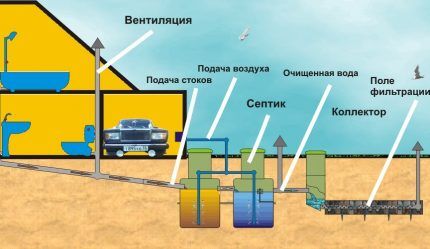
Then the liquid flows into the next compartment, equipped with ventilation, where aerobic microorganisms process wastewater.They form activated sludge, which can later be used as fertilizer. The result of two-stage purification is a slightly cloudy liquid that is not yet suitable for use.
It turns into process water or simply ends up in the ground (ditch, pond) after undergoing post-treatment, which is carried out in the following way:
- on the filtration field;
- in the infiltrator;
- directly in the ground;
- in the filter well.
A typical multi-stage system, which has dozens of design options, is good because it effectively cleans sewage waste, reduces cooperation with sewer trucks to a minimum and keeps the ecology of the garden plot clean. Now let’s take a closer look at the design of the filtration field.
PF design features
A filtration field is a relatively large area of land where secondary purification of liquid occurs.
This cleaning method is exclusively biological, natural in nature, and its value is in saving money (no need to buy additional devices or filters).
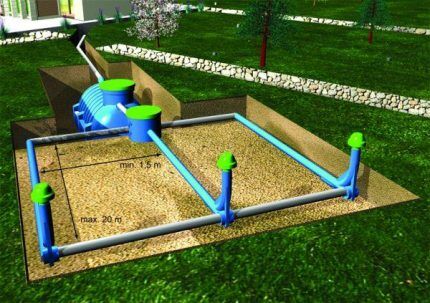
A typical filtration field design is a system of parallel laid drainage pipes (drains), which extend from the collector and are placed at regular intervals in ditches with a thick sand and gravel layer.
Previously, asbestos-cement pipes were used, but now there is a more reliable and economical option - plastic drains. A prerequisite is the presence of ventilation (vertically installed risers that provide oxygen access to the pipes).
The design of the system is aimed at ensuring that the liquid is evenly distributed over the designated area and has a maximum degree of purification, so there are several important points:
- distance between drains – 1.5 m;
- length of drainage pipes – no more than 20 m;
- pipe diameter – 0.11 m;
- intervals between ventilation risers – no more than 4 m;
- the height of the risers above ground level is at least 0.5 m.
To allow natural movement of liquid, the pipes have a slope of 2 cm/m. Each drain is surrounded by a filtering “cushion” of sand and pebbles (crushed stone, gravel), and is also protected from soil ingress by geofabric.
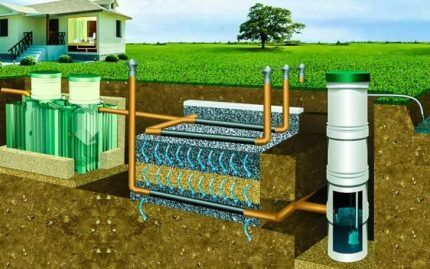
There is one condition, without which the installation of a septic tank with a filtration field is impractical. Special permeability properties of the soil are required, that is, on loose coarse and fine clastic soils that do not have connections between particles, it is possible to construct a post-treatment system, but dense clay soils, the particles of which are connected in a consolidated manner, are not suitable for this.
Typical device diagram
Whatever the general dimensions of the filtration field, its design consists of the following parts:
- collector (control well, distribution well);
- networks of plastic drains (drainage pipes with holes);
- ventilation risers;
- filter pad.
Traditionally, the drainage layer is made of sand and gravel (crushed stone, pebbles). Geotextiles are used to protect drains. A sewer system with PF looks like this:
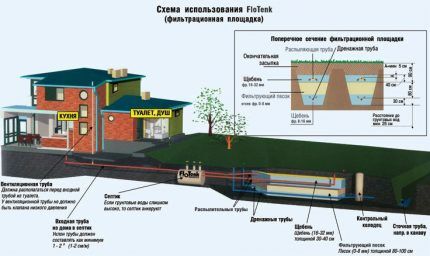
When building a filtration field with your own hands, it is not necessary to build the collector yourself - you can find plastic sewer containers of the required volume on sale.
They often do without a distribution well, connecting directly the septic tank and the pipe system - but this is convenient for small-sized PFs.
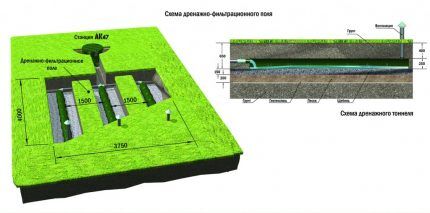
Sometimes, instead of PF, ready-made plastic devices - infiltrators - are used. They help out when there is a shortage of free space, and the soil does not have layers of loam and sandy loam and has sufficient permeability properties.
If desired, you can install several infiltrators connected by pipes in series.

Next, we’ll look at how to properly design and install a PF.
Designing a filter field
Drawing up a project is a mandatory stage before any serious construction. It is necessary to accurately make markings, make calculations, create estimates, prepare materials, and take into account all the nuances.
A professionally drawn up project will protect you from mistakes that are typical for inexperienced beginners.
How to choose a scheme and choose a location?
The choice of scheme depends on three factors:
- septic tank type;
- availability of free territory;
- cleaning requirements.
The fact is that the degree of cleaning differs between different septic tanks. For example, biological treatment stations (Topas, Astra, Eurobion) do not require a filtration field at all: 98% purified water immediately enters the drainage trench or reservoir.
Septic tanks built independently from concrete rings, bricks or tires, on the contrary, are not effective treatment facilities in themselves, so the liquid coming out of them requires additional purification.
We recommend that you familiarize yourself with the instructions for self-installation of various types of septic tanks:
- Septic tank made of concrete rings: device, diagrams + step-by-step installation process
- How to construct a brick drainage pit: options and methods of construction
- How to build a septic tank from tires with your own hands: step-by-step instructions
- How to make a two-chamber septic tank from concrete rings: construction instructions
As a rule, all sewerage elements are located in one line, that is, they are lined up alternately in one direction from the house - first the septic tank, then the filtration field.
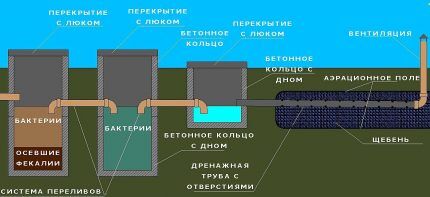
This means that when installing a septic tank, it is necessary to keep in mind that part of the free territory behind it will be needed for the construction of a PF (or, at a minimum, installation of an infiltrator).
When discharging wastewater in volume, the principle works: the more “branchy” and longer the network of drainage pipes, the more effective the treatment.
It is worth initially paying attention to the specifics of the design of filter fields:
Sizing calculations and budgeting
To correctly calculate the size of the field, it is necessary to take into account the daily amount of runoff and soil composition. If you know exactly the characteristics of the soil, you can start from the volume of the septic tank.
The table will help you calculate the filter field.

But these are rough estimates. There are tables that allow you to more accurately determine the size of the “working” area. They are based on taking into account such qualities as soil permeability.
Here is a version of such a table that may be useful to owners of suburban areas with clay or sandy soils.
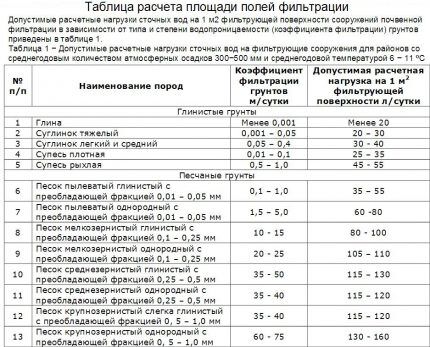
Peat indicators correspond to data on silty sand, and pebble and gravel have the maximum water permeability: their filtration coefficient is 100-200 m/day. There are no permissible load standards for them, since such a loose composition is capable of passing any volume of liquid.
Having determined the size of the field, you can count the number of pipes, ventilation risers (on average 1-2 for each drain), backfill (gravel, pebbles, crushed stone, sand), geotextiles, and then calculate the approximate cost of all materials.
Installation instructions for PF
In addition to the materials listed, you will need tools for excavating soil (shovels, buckets, wheelbarrows). The trenches intended for drains are not as deep as a pit for a septic tank, so construction equipment need not be involved. However, several pairs of workers will speed up the process.
The cycle of work on constructing a filtration field can be roughly divided into a number of standard stages:
Stage No. 1 - construction of trenches
At the first stage, it is necessary to prepare a place for laying perforated pipes. There are two ways: you can dig one large pit, and then it will be more convenient to arrange drainage and assemble a structure from pipes, or you can make several trenches (according to the number of drains), which will significantly reduce construction time.
The depth of the pit must be such that the liquid in the pipes does not freeze during the cold season, that is, an extensive pipe system must be placed below the freezing level of the soil. When constructing ditches, you need to remember a slight slope, allowing the liquid to move naturally - by gravity. The slope is 1.5-2 cm/meter of pipe.
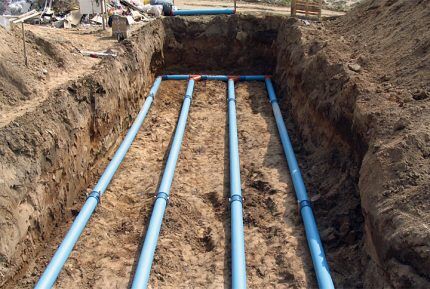
During the construction of PFs, strict geometry is adhered to. The pit, as a rule, has a square or rectangular shape, and the trenches are the same in length. Suppose you need a total length of pipes of 60 m - you can make 4 branches of 15 m each or 6 branches of 10 m each. The length of one drain is the distance from the inlet pipe (or collector) to the last ventilation “mushroom”.
The lower part of the trenches is covered with coarse sand (from 10 cm to 1 m), then 0.4-0.5 m with gravel (crushed stone, pebbles).If drainage drains are needed, they are located in the ground under the sand, but not less than 1 m above the groundwater.
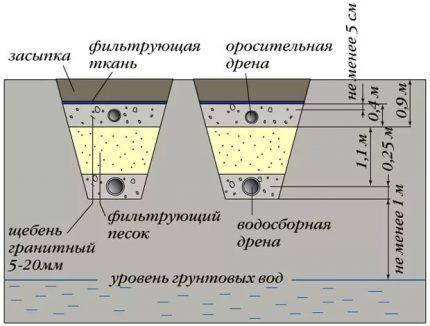
The drainage pipes lead to a storage tank located on the opposite side of the septic tank.
Stage No. 2 - laying perforated pipes
Plastic drainage pipes are laid on the prepared base. The process itself is quite simple, the main thing is to choose the right pipes.
You can buy ready-made ones - smooth or corrugated, with perforations and a textile layer, or you can take ordinary sewer pipes and drill holes in them with a drill. The recommended drain diameter is 100-110 mm.
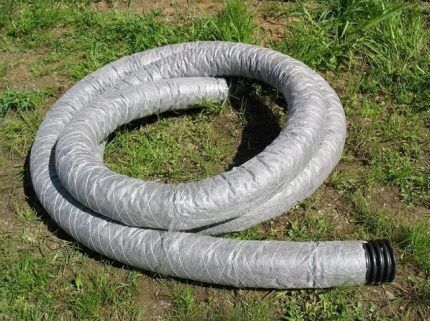
Along with the pipes, you must also purchase a set of fittings to connect different elements. You will need angles and tees. The process of laying drainage pipes is described in more detail in this material.
Stage No. 3 - ventilation device
A ventilation system is necessary to ensure that oxygen gets inside the pipes, without which aerobic bacteria lose their viability. For ventilation risers, you can use ordinary gray sewer pipes, covering them with lids on top to protect them from debris.

The minimum height of ventilation pipes above the ground is 0.5 m. Usually they try to make them more neat or decorate in order to preserve the aesthetic appeal of the garden landscape.
Stage No. 4 - backfilling and further maintenance
After laying perforated pipes, it is necessary to backfill. From the sides and top, each branch is covered with crushed stone (the top layer is approximately 50 mm), then covered with a layer of geotextile and a finishing thick layer of soil. Geotextiles are used to prevent pipes from silting. The soil above the drains must be compacted, but so as not to damage the pipes.
The filtration field is included in the work together with the septic tank. There are no special actions for servicing drains. It is believed that the PF functions trouble-free for 6-7 years, after which it is necessary to disassemble the structure and replace the gravel filter. To increase the service life of the filter, geotextiles are also placed under a layer of gravel (crushed stone).
As an easy-to-install alternative to the traditional filtration field, a modern version has been developed - an infiltration cassette, the installation of which will be shown in the following photo selection:
Are there other solutions?
Not everyone can use the filtration field as a method of post-treatment of sewage waste. What should those who own a piece of clay land or have built a house in an area with a high groundwater level do?
Recommendations for choosing septic tanks for high groundwater levels are described In this article.
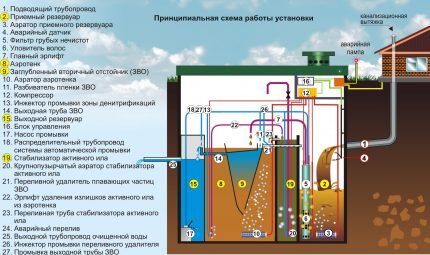
You can also create a sewer system with filter well, but its installation also requires a number of conditions (for example, non-clayey soil and the location of groundwater a meter below the conditional bottom of the well).
If you simply install a septic tank without further treatment, insufficiently clarified and disinfected water will enter the soil and an unpleasant odor may appear.
Conclusions and useful video on the topic
Videos with useful information about the construction of wastewater treatment plants.
Septic tank Rostock with PF:
The theory of arranging a septic tank with filtration fields in pictures:
You can build a filtration field with your own hands if you make the calculations correctly and fulfill all installation conditions. To determine the type of soil or choose a septic tank, you can contact specialists. A complete wastewater treatment system is a guarantee of environmental cleanliness, and therefore comfort.
After studying our article, you still have questions about arranging the filtering field, please write them in the comments section and we will try to answer them promptly.




It is best, of course, to have an engineer’s education in order to install a septic tank with ground treatment systems on your site. But what to do if there are no crusts and no experience? How to make the project as convenient as possible for yourself, and also not offend your neighbors on the site!? Perhaps it would be better to order a project with calculations from a specialized organization specializing in the installation of autonomous sewage systems or make a calculation according to this information? Maybe someone has already tried to do it themselves and will give good advice.
Ideally, of course, attract specialists to do all the work: from design to installation of a septic tank and filtration fields.But the implementation of such a project exclusively by specialists will cost a pretty penny, in simple terms. Therefore, many focus on standard designs of septic tanks and filtration fields, adapting them to suit conditions.
The article has excellent introductory material, plus you can use the site search and find more suitable options for your site and home.
Regarding the comments above regarding the fact that geotextiles have no place in filtration fields, here I disagree with Alexander and Sergey. This material does not come into direct contact with the filtration fields, but is located behind layers of crushed stone and sand. Therefore, geotextiles will not become clogged with suspension, which prevents the growth of harmful microorganisms in this material.
I can give advice, I have experience installing a ground treatment system!!!
Hello Igor. You can advise on the drainage field. Plot from the Sergiev Posad region.
Geotextiles have no place in the filtration field.
Agree. The pores of geotextiles will quickly become clogged with suspension and various microorganisms will begin to multiply in them. The process of colmatation will occur. Geotextiles are a good material, but not for this purpose.
The drainage well made of concrete rings (1.5 m, 5 pieces) stopped draining wastewater after Astra 8, they say it silted up. Previously worked for 6 years. I pumped it out with a sludge sucker and washed it - it didn’t help. What should I do?
Good afternoon. Are there any restrictions for the filtration field: at what distance from the well should the field be located; Can people get intestinal infections from the field?
I made a mistake in writing my email
Good afternoon.Are there any restrictions for the filtration field: at what distance from the well should the field be located; Can people get intestinal infections from the field?
You will be digging up pipes wrapped in geotextile in a couple of years; bacteria will make the fabric waterproof. These pipes are intended for drainage, not for septic tanks.
Geotesting at the bottom of the ditch is also very controversial. Dirt will still not flow onto the crushed stone from below, but the geotextile may silt over time.
As an option: in the filtration well at the end of the 110th pipe I hung a filter from an industrial vacuum cleaner ALVG-F11.001.00.00 Lanit 500 (F380x920) for UVP-1200, designed for collecting shavings and wood dust, costs 650 rubles, volume ~ 100 liters. Over three years, I filtered 15-17 kg of organic sediments (similar to sapropel). Aerobic septic tank, Traidyanis, 1200 l. The depth of the filtration well is 1.2 m. I use living bacteria, a bioactivator for septic tanks and cesspools, Biosept, poured into both the septic tank and the filter.
As an option: in the filtration well at the end of the 110th pipe I hung a filter from an industrial vacuum cleaner ALVG-F11.001.00.00 Lanit 500 (F380x920) for UVP-1200, designed for collecting shavings and wood dust, costs 650 rubles, volume ~ 100 liters. Over three years, I filtered 15-17 kg of organic sediments (similar to sapropel). Aerobic septic tank, Traidyanis, 1200 l. The depth of the filtration well is 1.2 m. I use living bacteria, a bioactivator for septic tanks and cesspools Biosept, and I regularly add it to the septic tank and the filter.